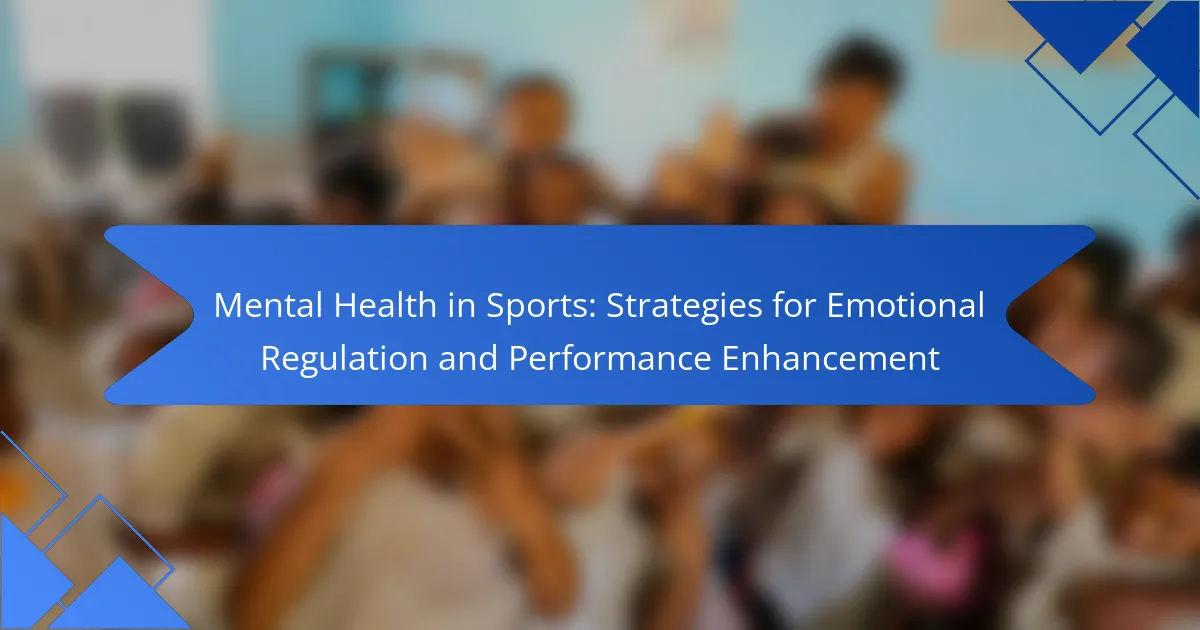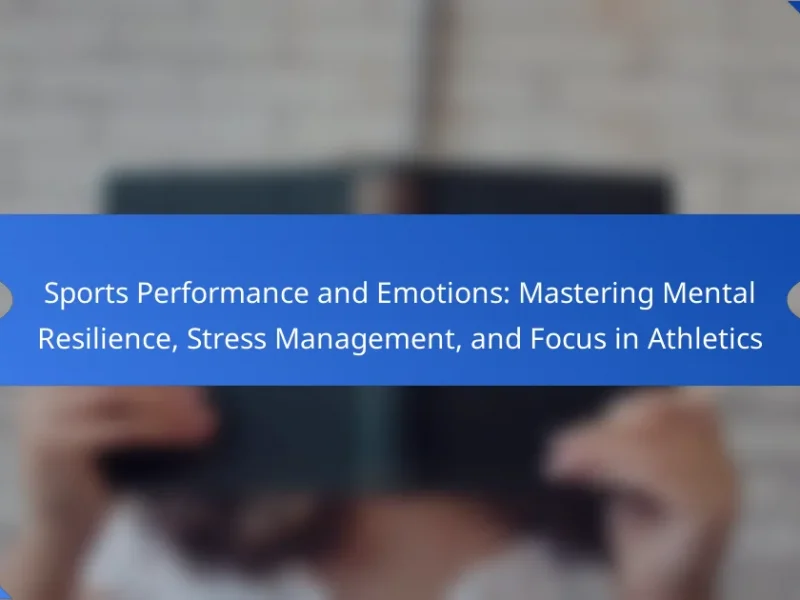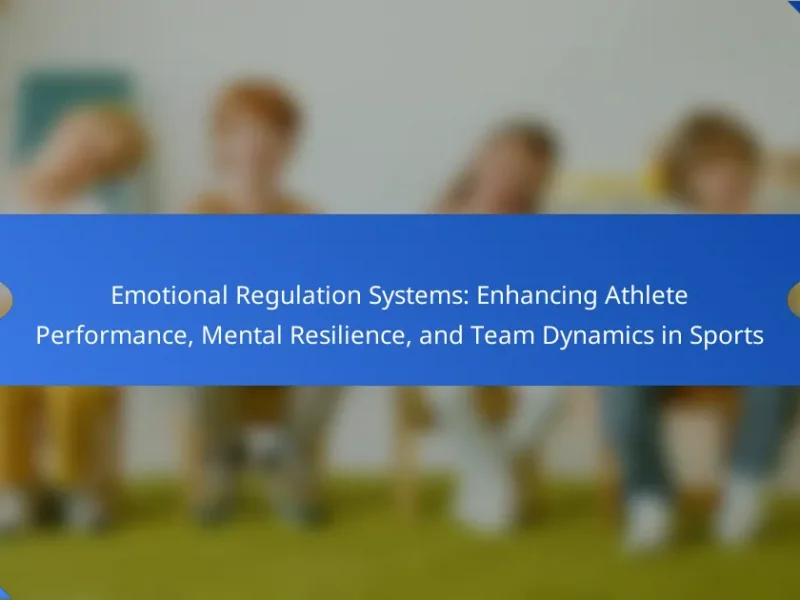Managing emotions effectively is crucial for athletes to enhance performance and maintain mental health. This article explores emotional regulation systems, universal strategies like mindfulness and cognitive restructuring, unique techniques employed by elite athletes, and emerging practices such as biofeedback and narrative therapy. It also addresses the limitations of current strategies and offers best practices for effective emotional regulation in sports.
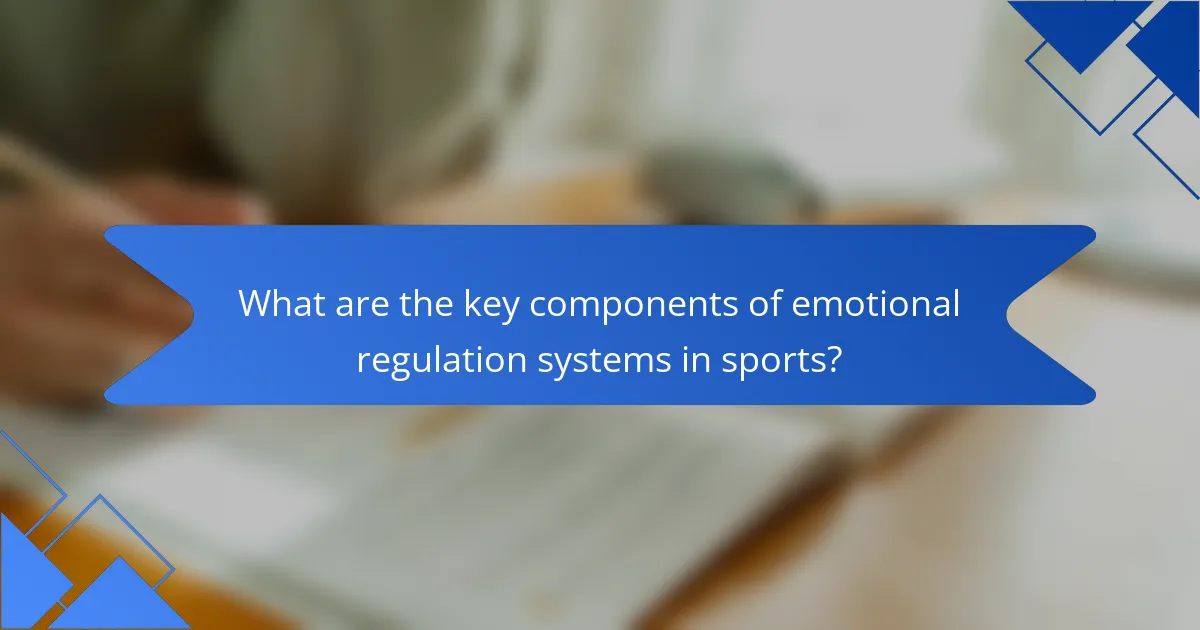
What are the key components of emotional regulation systems in sports?
Emotional regulation systems in sports include awareness, control, and expression of emotions. Key components are self-awareness, cognitive appraisal, coping strategies, and social support.
Self-awareness enables athletes to recognize their emotional states, facilitating better performance under pressure. Cognitive appraisal involves interpreting emotional experiences, influencing reactions to stressors. Coping strategies, such as mindfulness and visualization, help manage anxiety and enhance focus. Social support provides emotional stability, fostering resilience in challenging situations.
Incorporating these components can lead to improved mental health and athletic performance.
How do emotional regulation systems impact athlete performance?
Emotional regulation systems significantly enhance athlete performance by improving focus and resilience. Effective emotional regulation allows athletes to manage stress, maintain motivation, and recover from setbacks. Studies show that athletes with strong emotional regulation skills exhibit higher performance levels and better team dynamics. For instance, a study found that emotional intelligence correlates positively with athletic success, highlighting the unique attribute of emotional regulation in sports.
What role does mental health play in sports performance?
Mental health significantly influences sports performance by affecting focus, resilience, and emotional stability. Athletes with strong mental health exhibit better coping strategies, enhancing their ability to handle pressure. Research indicates that mental well-being correlates with improved performance metrics, such as reaction times and decision-making skills. Effective emotional regulation techniques, such as mindfulness and visualization, can further amplify performance outcomes. Prioritizing mental health not only fosters individual success but also cultivates a positive team environment, ultimately leading to collective achievements.
What are common mental health challenges faced by athletes?
Athletes commonly face mental health challenges such as anxiety, depression, and burnout. These issues can stem from performance pressures, injuries, and balancing personal life with training demands.
Anxiety manifests as excessive worry about performance, leading to decreased focus. Depression may arise from setbacks or chronic stress, impacting motivation and overall well-being. Burnout results from prolonged stress without adequate recovery, characterized by emotional exhaustion and reduced performance.
Understanding these challenges is crucial for developing effective strategies for emotional regulation and enhancing performance. Addressing mental health in sports can lead to improved athlete resilience and overall success.
How can emotional regulation enhance focus and concentration?
Emotional regulation enhances focus and concentration by managing stress and anxiety levels. Improved emotional control allows athletes to maintain composure during competition, leading to better decision-making and performance. Studies indicate that athletes who practice emotional regulation techniques, such as mindfulness, demonstrate increased attention and reduced distractions. This unique attribute of emotional regulation directly correlates with enhanced overall performance in sports.
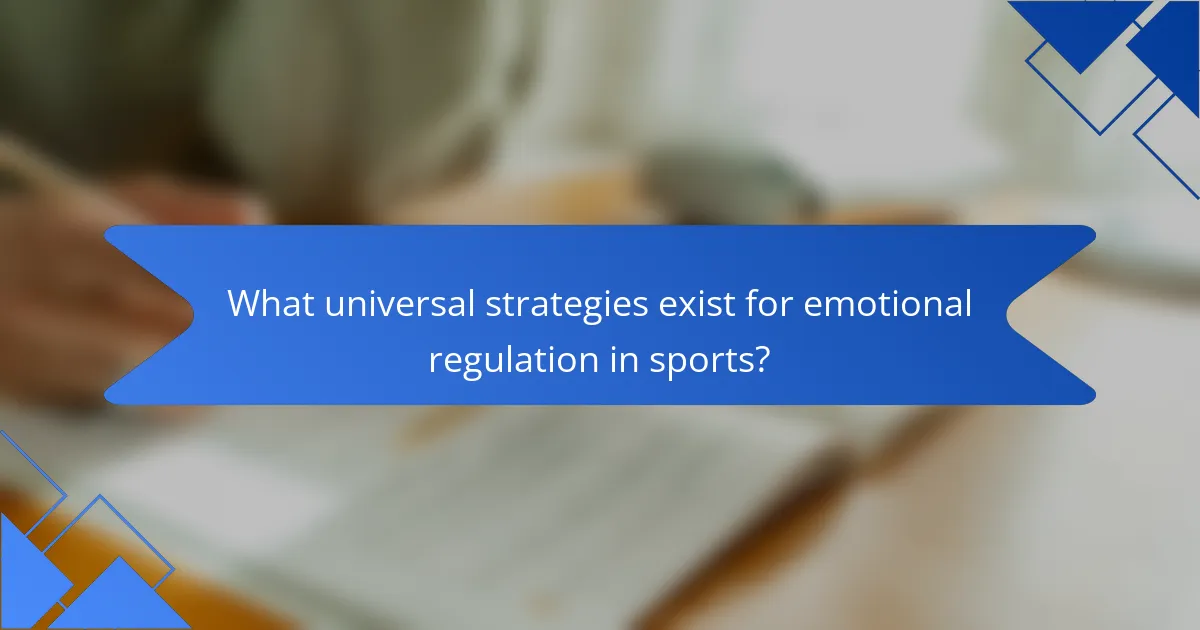
What universal strategies exist for emotional regulation in sports?
Emotional regulation in sports can be enhanced through universal strategies such as mindfulness, cognitive restructuring, and goal setting. Mindfulness helps athletes stay present and manage anxiety, while cognitive restructuring allows them to reframe negative thoughts. Goal setting provides clear targets that enhance focus and motivation. These strategies improve mental resilience and performance consistency.
How do athletes practice mindfulness for emotional control?
Athletes practice mindfulness to enhance emotional control by focusing on the present moment and reducing stress. Techniques include meditation, breathing exercises, and visualization. These practices improve concentration, foster resilience, and help manage anxiety during competition. Research indicates that consistent mindfulness training can lead to better performance outcomes and emotional stability, making it a valuable strategy in sports.
What cognitive-behavioral techniques are effective for emotional regulation?
Cognitive-behavioral techniques such as cognitive restructuring, mindfulness, and exposure therapy are effective for emotional regulation in sports. These methods help athletes identify and modify negative thought patterns, enhance focus, and gradually face anxiety-inducing situations. Cognitive restructuring allows athletes to replace unhelpful thoughts with positive affirmations. Mindfulness practices improve emotional awareness and control, while exposure therapy assists in reducing performance-related fears. Implementing these techniques can lead to improved mental resilience and enhanced athletic performance.

What unique emotional regulation techniques are used by elite athletes?
Elite athletes utilize unique emotional regulation techniques such as mindfulness, visualization, and self-talk to enhance performance. Mindfulness helps athletes stay present, reducing anxiety. Visualization allows them to mentally rehearse successful performances, boosting confidence. Self-talk involves positive affirmations to counter negative thoughts. These strategies foster resilience and focus, crucial for peak performance.
How do visualization and imagery contribute to emotional regulation?
Visualization and imagery enhance emotional regulation by allowing athletes to mentally rehearse scenarios, reducing anxiety and improving focus. These techniques create positive mental states, which can lead to better performance outcomes. Research shows that mental imagery can activate similar brain regions as actual performance, reinforcing skills and confidence. As a result, athletes often report increased emotional stability and resilience during competition.
What are the steps for effective visualization techniques?
Effective visualization techniques for mental health in sports involve several key steps.
1. Identify specific emotional states to visualize, such as anxiety or confidence.
2. Create vivid mental images that represent desired outcomes or feelings.
3. Practice visualization regularly to reinforce mental imagery and emotional regulation.
4. Integrate visualization with physical practice to enhance performance and emotional resilience.
How do team dynamics influence emotional regulation strategies?
Team dynamics significantly influence emotional regulation strategies by fostering a supportive environment. Positive interactions among teammates enhance emotional resilience, allowing athletes to manage stress effectively. Research shows that cohesive teams exhibit lower anxiety levels, improving overall performance. Team members who communicate openly share coping strategies, promoting individual and collective emotional regulation.
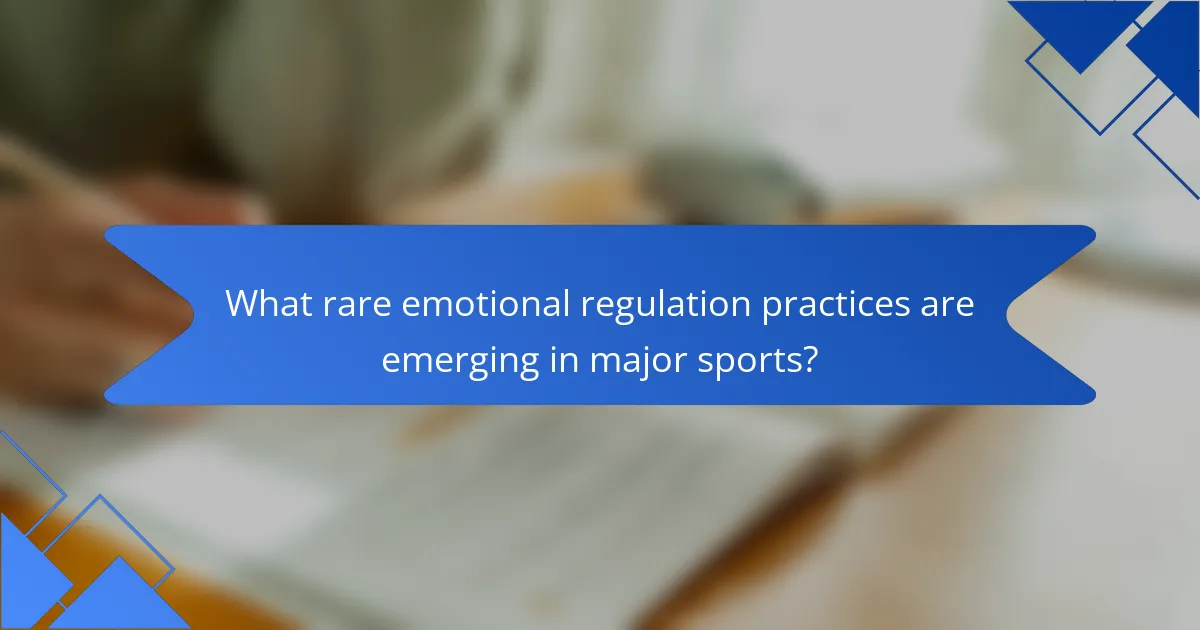
What rare emotional regulation practices are emerging in major sports?
Emerging rare emotional regulation practices in major sports include mindfulness integration, biofeedback techniques, and narrative therapy. These practices enhance athletes’ mental resilience and focus. For instance, mindfulness meditation has shown to improve concentration and reduce anxiety. Biofeedback helps athletes gain awareness of physiological responses, allowing for better emotional control. Narrative therapy encourages athletes to reshape their personal stories, fostering a positive mindset. These innovative strategies are gaining traction as teams recognize their impact on performance enhancement and overall mental health.
How are biofeedback and neurofeedback being utilized in sports?
Biofeedback and neurofeedback enhance mental health in sports by improving emotional regulation and performance. These techniques provide athletes with real-time data on physiological functions, allowing for better self-awareness and control over stress responses.
Biofeedback helps athletes monitor heart rate, muscle tension, and breathing patterns, enabling them to practice relaxation techniques effectively. Neurofeedback focuses on brainwave activity, training athletes to achieve optimal mental states for peak performance.
Studies show that athletes using these methods report reduced anxiety and improved focus, leading to enhanced performance outcomes. Implementing biofeedback and neurofeedback as part of training regimens can create a unique advantage in competitive sports.
What innovative technologies support emotional regulation in athletes?
Innovative technologies supporting emotional regulation in athletes include biofeedback devices, virtual reality training, and mobile mental health applications. Biofeedback devices measure physiological responses, allowing athletes to gain insights into their emotional states. Virtual reality training immerses athletes in controlled environments to practice coping strategies. Mobile applications provide on-the-go resources for mindfulness, stress management, and emotional tracking, enhancing athletes’ mental resilience. Each technology uniquely contributes to improved emotional regulation and performance enhancement.
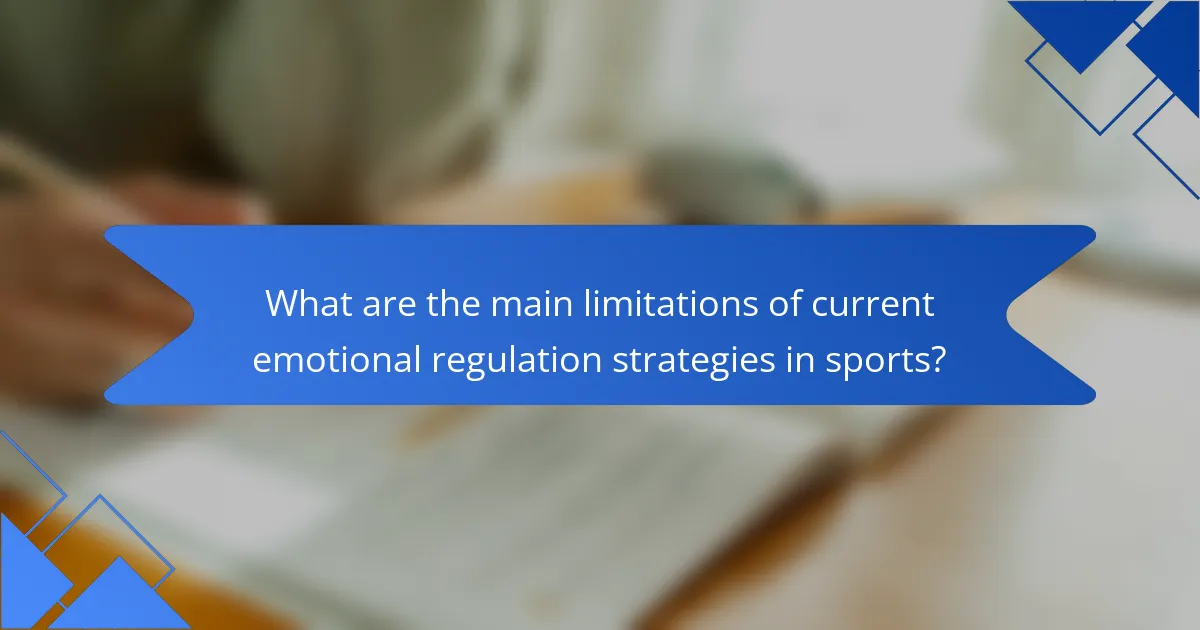
What are the main limitations of current emotional regulation strategies in sports?
Current emotional regulation strategies in sports often fall short due to their one-size-fits-all approach, lack of personalization, and limited integration with physical training. These strategies may not account for individual differences in athletes’ emotional responses, leading to ineffective outcomes. Additionally, many techniques lack empirical support, which undermines their credibility and application. As a result, athletes may struggle to effectively manage their emotions during competition, affecting performance and mental health.
What barriers do athletes face in implementing emotional regulation techniques?
Athletes face several barriers in implementing emotional regulation techniques, including stigma, lack of education, and time constraints. Stigma surrounding mental health can prevent athletes from seeking help or using emotional regulation strategies. Many athletes may lack education on effective techniques, limiting their ability to apply them. Additionally, the demanding schedules of training and competition often leave little time for athletes to focus on mental health practices.
How can coaching staff better support athletes’ emotional regulation?
Coaching staff can better support athletes’ emotional regulation by implementing structured mental health strategies. Regular check-ins foster open communication, enabling athletes to express their feelings. Training in mindfulness techniques helps athletes manage stress and anxiety. Providing access to mental health professionals offers tailored support. Encouraging a team culture that prioritizes mental well-being promotes resilience and emotional awareness.
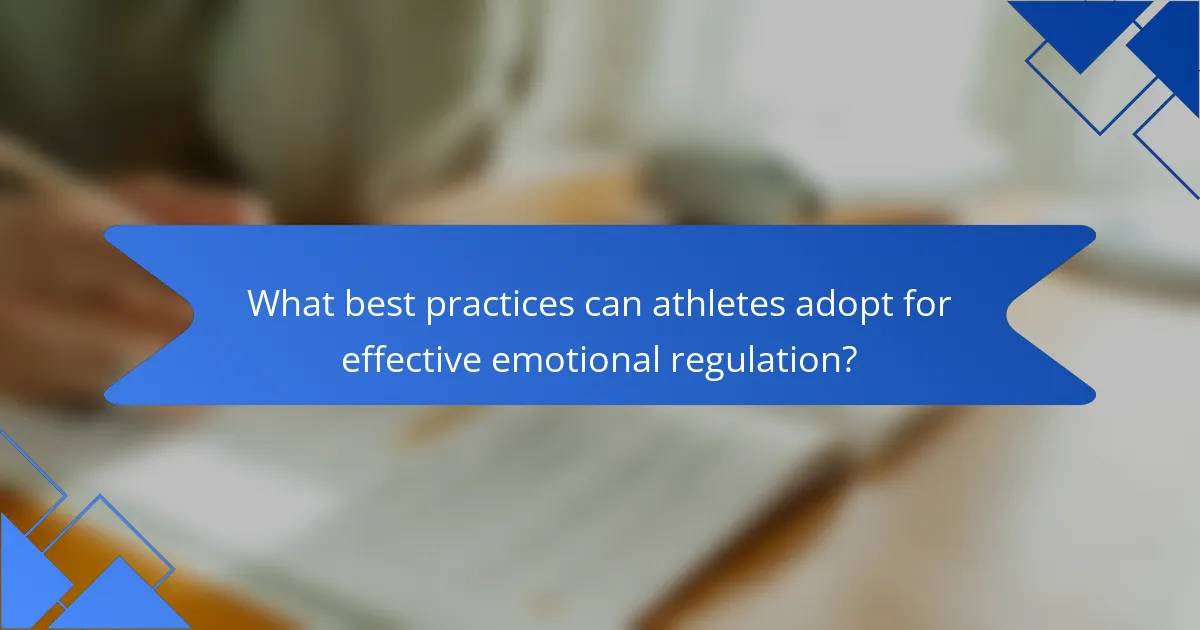
What best practices can athletes adopt for effective emotional regulation?
Athletes can adopt several best practices for effective emotional regulation. These include mindfulness techniques, cognitive restructuring, and maintaining a consistent routine. Mindfulness helps athletes stay present and manage stress. Cognitive restructuring allows for reframing negative thoughts into positive ones. A consistent routine fosters a sense of control and predictability, enhancing overall performance.
What common mistakes should athletes avoid in emotional regulation?
Athletes should avoid common mistakes like ignoring emotional signals, suppressing feelings, and neglecting self-care. Recognizing emotions is crucial for performance enhancement. Suppressing emotions can lead to increased stress and decreased focus. Prioritizing mental health through practices like mindfulness and seeking support can improve emotional regulation.
How can athletes create a personalized emotional regulation plan?
Athletes can create a personalized emotional regulation plan by identifying triggers, setting specific goals, and incorporating coping strategies. Start by recognizing situations that induce stress or anxiety during competition. Next, establish clear emotional goals, such as maintaining composure or enhancing focus. Finally, implement techniques like mindfulness, deep breathing, or visualization to manage emotions effectively. Regularly review and adjust the plan to optimize performance and emotional well-being.
